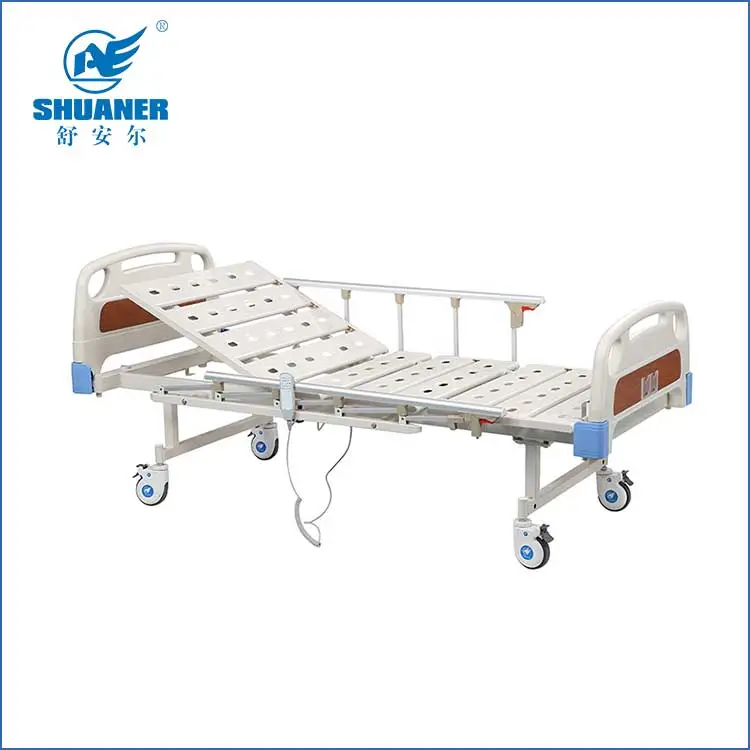- English
- Español
- Português
- русский
- Français
- 日本語
- Deutsch
- tiếng Việt
- Italiano
- Nederlands
- ภาษาไทย
- Polski
- 한국어
- Svenska
- magyar
- Malay
- বাংলা ভাষার
- Dansk
- Suomi
- हिन्दी
- Pilipino
- Türkçe
- Gaeilge
- العربية
- Indonesia
- Norsk
- تمل
- český
- ελληνικά
- український
- Javanese
- فارسی
- தமிழ்
- తెలుగు
- नेपाली
- Burmese
- български
- ລາວ
- Latine
- Қазақша
- Euskal
- Azərbaycan
- Slovenský jazyk
- Македонски
- Lietuvos
- Eesti Keel
- Română
- Slovenski
- मराठी
- Srpski језик
Advantages and disadvantages of two-function electric beds
2024-11-07
The two-function electric hospital bed is a common medical device, mainly used in hospitals, nursing institutions and home care environments to help patients achieve convenient posture adjustment while lying in bed. Compared with traditional manual beds, two-function electric beds use electric drive systems to enable certain parts of the bed to automatically rise and fall, improving the comfort, convenience and functionality of the bed. The following are the advantages and disadvantages of two-function electric beds:
Advantages:
Electric adjustment: Patients or caregivers can adjust the head and leg angles of the bed through simple button operations, without manual pushing and pulling, saving physical strength and time, especially suitable for patients who need to stay in bed for a long time.
Easy posture adjustment: The patient's position can be easily adjusted to help patients improve breathing, digestion and blood circulation.
Reducing nursing work intensity: Nurses can adjust the bed through remote control or bedside controllers, reducing the number of manual patient moves, reducing the work intensity of nurses, especially for seriously ill patients or patients with limited mobility.
Adapt to different conditions: According to the conditions of different patients, adjust the angle of the bed to provide personalized care. For example, for patients with breathing difficulties, the head can be raised; for patients with lower limb edema, the legs can be raised.
Customized comfort: By adjusting the angle of the bed, patients can be provided with a comfortable resting posture, pressure points can be reduced, and bedsores can be prevented.
Reduce discomfort: For patients who need to stay in bed for a long time, adjusting the angle of the bed can reduce the pressure on the spine, waist and joints, and relieve discomfort.
Electric control: Compared with traditional manual beds, electric beds adjust the bed posture through electric drive, which is more stable and less prone to accidental injuries.
Remote control operation: Some dual-function electric beds are equipped with remote controls, which can facilitate patients and caregivers to control the bed away from the bed and reduce unnecessary movement of patients.
Two-function electric beds usually have removable and washable mattresses and surfaces to facilitate the hygiene of the bed. The bed structure is reasonably designed, which is convenient for cleaning the gaps under and beside the bed and keeping the environment clean.
Two-function electric beds are not only suitable for hospitals, but also for elderly care, rehabilitation treatment, home medical care and other environments. It can provide good support and comfort, especially for patients who are bedridden for a long time.
Disadvantages:
1. Compared with traditional manual beds, dual-function electric beds are more expensive. Electric drive systems, remote controls, and other high-tech features increase costs, resulting in higher purchasing budgets for patients or care institutions.
2. There is a risk of damage or failure in the drive system, battery, remote control, and other parts of the electric bed, especially after long-term use, the electric drive components may need to be repaired or replaced.
3. Two-function electric beds rely on electricity to operate, and the angle of the bed may not be adjusted when the power is off, causing inconvenience to the patient. Especially in an emergency, power problems may cause the bed to lose function.
4. Compared with traditional beds, two-function electric beds are usually larger in size and more complex in structure, and may require more space for placement.
5. Although electric beds are convenient to use, there may be a certain learning curve for some older or less familiar caregivers to operate the remote control or buttons of the electric bed.
6. Electric beds may tilt or the electric part may fail, causing patients to accidentally fall or get injured. Especially when there is no professional caregiver operating, the automatic adjustment function of the bed may be misoperated, causing unnecessary risks.
Summary
Two-function electric hospital beds have many advantages, especially in improving patient comfort, nursing efficiency, and providing personalized care. Its electric adjustment function greatly reduces the burden on nursing staff and improves the quality of life of patients. However, high prices, maintenance costs, electricity dependence, and other issues are also factors that need to be considered.




